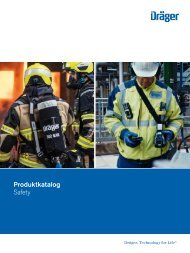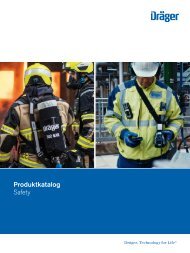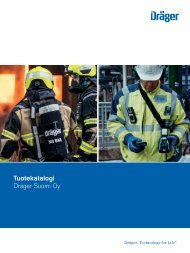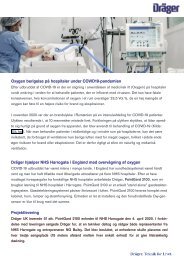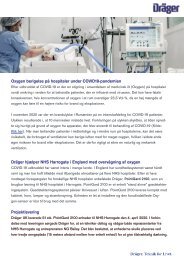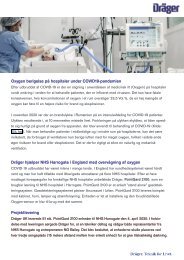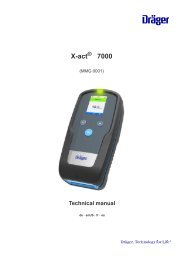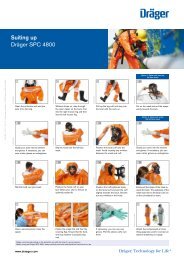Carcinogenic Substances at Work
You also want an ePaper? Increase the reach of your titles
YUMPU automatically turns print PDFs into web optimized ePapers that Google loves.
ACRYLONITRILE<br />
Acrylonitrile – chemical and<br />
physical properties¹<br />
CAS no.<br />
Appearance and colour:<br />
Odour threshold:<br />
Melting point:<br />
Boiling point:<br />
Flash point/flash point range:<br />
Flammability:<br />
Explosion thresholds:<br />
LEL (lower explosion limit)<br />
UEL (upper explosion limit):<br />
107-13-1<br />
Pungent<br />
3.7–35.8 ppm<br />
-82 °C<br />
77 °C<br />
-5 °C<br />
Highly flammable<br />
2.8 vol.%<br />
28 vol.%<br />
SELECTED INTERNATIONAL WORKPLACE EXPOSURE<br />
LIMITS FOR ACRYLONITRILE (8 HOURS TWA)<br />
Country/Region Parts per million Mg/m³<br />
Europe 0.45 1<br />
Germany (acceptance level) 0.12 0.26<br />
Germany (tolerance level) 1.2 2.6<br />
USA (ACGIH) 2 4.3<br />
China (PC-STEL CN) – 2<br />
China (PC-TWA CN) – 1<br />
Singapore 2 PEL (LT) 4.3 PEL (LT)<br />
Is your country not included? <br />
Visit our hazardous substances d<strong>at</strong>abase VOICE for more<br />
inform<strong>at</strong>ion: www.draeger.com/voice<br />
MEASUREMENT OF<br />
ACRYLONITRILE<br />
Usually acrylonitrile synthesis and<br />
processing take place in a closed<br />
system. For continuous area<br />
monitoring for timely warning of leaks<br />
it is advisable to use permanently<br />
installed gas measurement devices<br />
with electrochemical sensors.<br />
Employees working in <strong>at</strong>-risk areas<br />
should be provided with a personal<br />
gas-measuring device th<strong>at</strong> uses<br />
an OV-A sensor. Regular room<br />
air samples can be taken with a<br />
detection tube and evalu<strong>at</strong>ed with the<br />
help of a Dräger-Tube® (Acrylonitrile<br />
0.5/a) and a pump.<br />
Dräger X-am® 8000<br />
Dräger Polytron® 7000<br />
Dräger Pac® 8000<br />
Dräger Short-term Tubes<br />
Find more inform<strong>at</strong>ion about suitable measuring equipment in<br />
the chapter "Measuring carcinogens".<br />
1 IFA. (n.d.). GESTIS Substance d<strong>at</strong>abase - Acrylonitrile. Gestis Substance D<strong>at</strong>abase. Retrieved July 3, 2020, from http://gestis-en.itrust.de/nxt/g<strong>at</strong>eway.dll/gestis_en/000000.<br />
xml?f=templ<strong>at</strong>es$fn=default.htm$vid=gestiseng:sdbeng$3.0<br />
2 Lumitos GmbH. (n.d.). Acrylnitril. Chemie.De. Retrieved July 3, 2020, from https://www.chemie.de/lexikon/Acrylnitril.html<br />
3 Agency for Toxic <strong>Substances</strong> & Disease Registry. (2011, March 3). Acrylonitrile. Toxic <strong>Substances</strong> Portal. https://www.<strong>at</strong>sdr.cdc.gov/substances/toxsubstance.asp?toxid=78<br />
4 European Chemicals Agency. (2018, August). Opinion on scientific evalu<strong>at</strong>ion of occup<strong>at</strong>ional exposure limits for Acrylonitrile (ECHA/RAC/ O-0000001412-86-188/F). ECHA. https://echa.<br />
europa.eu/documents/10162/13641/acrylonitrile_opinion_en.pdf/102477c9-a961-2c96-5c4d-76fcd856ac19<br />
9 | 33






